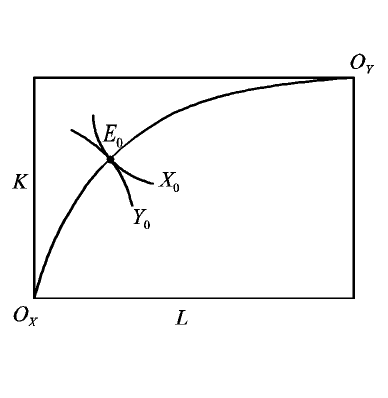|
If factors are re-allocated from one industry to the other, as for example in response to a change in relative prices (which cannot easily be shown in this diagram), movement will be along the efficiency locus. If factors are moved into industry Y, then movement is down and to the left along this locus, to the point shown above as E-1. If factors are moved into industry X, then equilibrium moves up and to the right to point E1.
|
|
At each point along the efficiency locus, factor proportions appear as the slopes of the rays from the two respective origins to the point. The ratio of the two factor prices at each point is given by the slope of the single straight line that is tangent to both isoquants at that point (single, because they are tangent to each other). Since factor proportions depend monotonically on relative factor prices, the two (different) ratios of factors employed in each industry must move in the same direction, as both factors are re-allocated along the efficiency locus.
Thus, for a small re-allocation into industry Y and out of industry X, numbered "-1" in the figure, the ratios of capital to labor employed must rise in both industries, and this in turn requires that the relative wage of labor, w/r shown by the (absolute) slope of the tangent to the isoquants, rises as well. That is, both isoquants become steeper as we move down and to the left along the efficiency locus.
This process continues until the corner of the box is reached at OX. At that point, all factors are employed in industry Y, whose factor proportions equal that of the country, and the factor prices are given by the slope of the Y-isoquant only. This is shown as the allocation numbered "-2".
Allocations "+1" and "+2" show the analogous movement of factors out of industry Y and into X. In both industries, this causes capital-labor ratios to fall and the relative wage of labor to fall as well.
|
|
A change in factor endowments appears as a change in the dimensions of the box. This is most easily done holding one corner of the box fixed, OX, and letting the opposite corner, OY, move to reflect the new factor endowments. Holding prices of goods and therefore factors constant (due to FPE), the ratios of capital to labor employed in each industry remain unchanged. Thus the new equilibrium allocation can be found by simply shifting the Y-industry factor-proportions ray along with OY, keeping it parallel to what it was before, and finding where it crosses the unchanged X-industry factor proportions ray.
The results, illustrated in the figures for "Less K," "More K," etc., are the Rybczynski Theorem results that a rise in K or a fall in L cause more of both factors to be allocated to capital-intensive industry X, and thus the output of X to rise, while output of Y falls. A proportional change in both factor endowments, on the other hand, causes both outputs to rise or fall together, in the same proportion.
|
